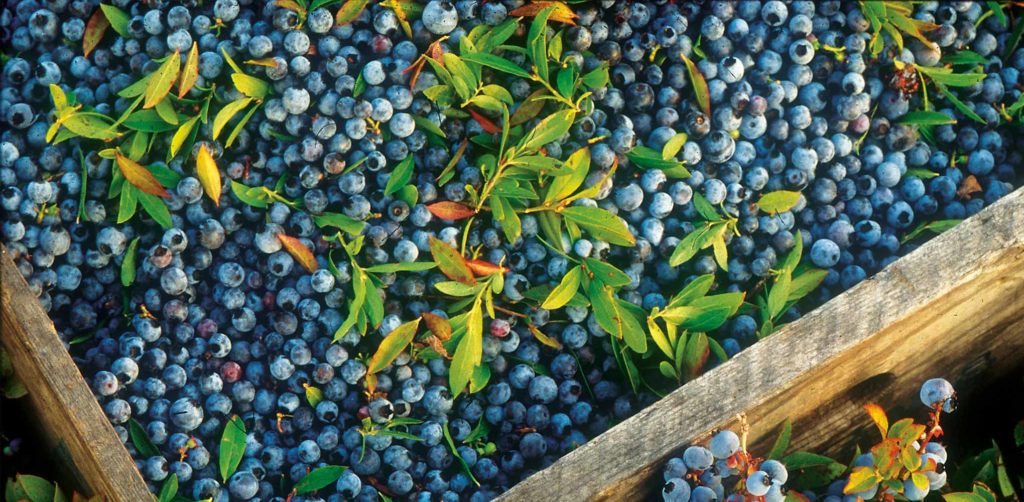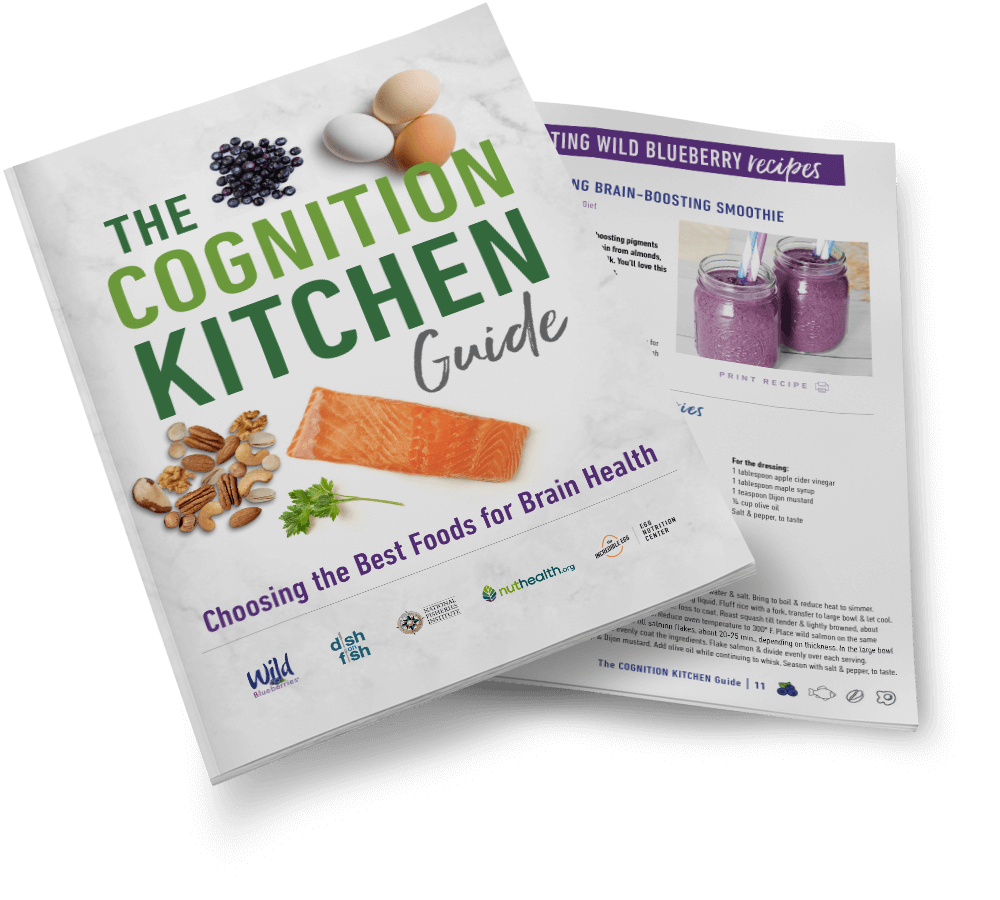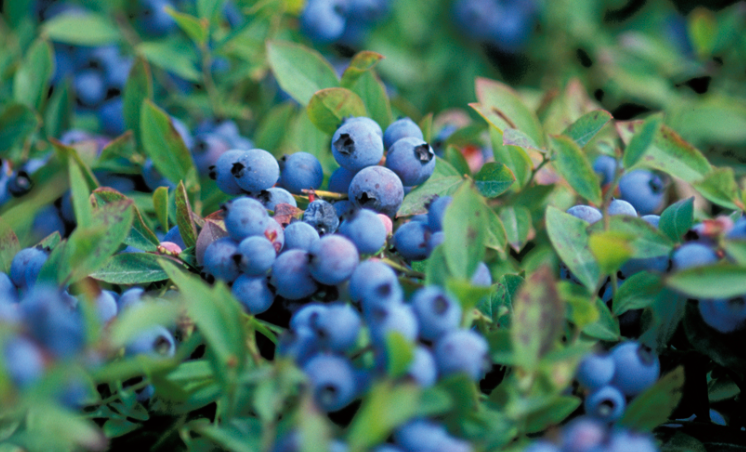Wild Blueberries and Your Brain
You love them for their unique taste, beautiful colors and diminutive size, but wild blueberries are more than just another berry!
Packed with plenty of essential nutrients, fiber, and antioxidants, these little berries are powerful health promoters. Let’s back up a bit and start with the basics, because where and how they grow play a part in wild blueberries’ brain-boosting potential.

What are wild blueberries?
Wild blueberries are native to the rocky, treeless barrens of Eastern Maine and Canada. These hardy plants can produce an abundance of berries, especially when warm summer days are interspersed with periods of cool fog. They’ve become accustomed to long, cold winters over the 10,000 years they’ve been growing in this unique climate.
Aside from their natural nutritional content, the hardiness of the plants may also be at least partly responsible for some of the berries’ health-promoting properties. In fact, wild blueberries have had importance both as a food and medicinal plant for thousands of years.
How do wild blueberries grow?
Wild blueberries grow in a very different way, compared to regular cultivated blueberries. Wild blueberries grow best on acidic soils. To grow and spread, the plant will send out shallow underground stems, called rhizomes, which then grow vertical green shoots along their length.
This type of growth results in a ‘carpet’ of wild blueberries which turns blue with a crop of berries in August, then brilliant red-purple in autumn when the plant’s leaves turn color. The beautiful blue pigments that we see on the berries at harvest time and in the leaves during autumn are due to the anthocyanin pigments.
In contrast, cultivated blueberries grow as a shrub, and need a milder, warmer climate. Each shrub is a particular variety with known attributes. Wild blueberries are hardy, scrappy plants that do best when they’re left to grow in the tough regions, where mother nature intended. And, unlike cultivated blueberry bushes, wild blueberry plants don’t appreciate human efforts to cross-breed or plant them—they prefer to fend for themselves against the elements.
Long ago, people noticed that wild blueberry plants were far more productive when the berries were harvested only every second year. To do this, after the berries were harvested, the plant was trimmed (or sometimes burned) to the ground. This process, still employed today by mowing, ensured abundant growth of the underground rhizomes and vertical shoots. Each vertical shoot is laden with flower buds, and each flower bud can produce a berry.
So what does the wild blueberry growing habit have to do with the berries’ effects on the brain? To put it simply, the impact of environmental stressors on wild blueberry plants likely increases both the amount and diversity of antioxidants in the berries. These natural plant compounds, found in both the berries and the leaves of the plants, are beneficial to the plant and help in their defense against animals and the harsh climate. Lucky for us, they are also helpful to humans, with the berries providing a potent (and delicious) source of health-promoting antioxidants.
Anthocyanins are antioxidants
Plants, including the many fruits and vegetables that we eat, contain an array of components that help them to survive and reproduce. Consider anthocyanins, the brilliant blue pigments found in berries and leaves of wild blueberries.
Anthocyanins serve a role in the blueberry fruit as a visual signal to foragers that the blueberry fruit is ripe and delicious. These pigments also have antioxidant effects, providing health benefits to those who eat them.
Anthocyanins are a key ingredient to the healthfulness of wild blueberries. Anthocyanins are found in the skin of the berry. And because of their small size, wild blueberries offer a higher skin-to-pulp ratio than regular blueberries and are therefore richer in these healthful pigments.
Oxidative stress (or, why we need antioxidants)
We’ve heard so much about antioxidants, and that they’re important, but why?
Quite simply, we need antioxidants because we’re constantly dealing with oxidative stress. Indeed all living things on Earth deal with oxidative stress. It comes as an undesirable side effect of our dependence on oxygen for biological energy production.
Oxygen is found throughout our bodies—including our brains. Sometimes oxygen is converted to unstable forms called free radicals, which can cause damage to cells and tissues. Along with the oxidative stress that comes with 24/7 normal metabolism, external factors like cigarette smoking and exposure to UV light or environmental pollution can exacerbate the formation of oxygen free radicals in the body.
Not all free radicals are bad or dangerous. However, when there is a prolonged excess of them—and not enough antioxidants around to offset their effects— a condition called oxidative stress is created. Oxidative stress is not the body’s preferred state, and it works to counteract the effects. One way it does that is by utilizing antioxidants to “clean up” excess free radicals.1
We’ve known for some time that oxidative stress in the body leads to progressive cell damage and underlies the aging process. Wild blueberries (and regular blueberries) are high in flavonoid antioxidants, especially anthocyanins. Antioxidant-active anthocyanins may reduce neurological decline and risk of neurodegenerative diseases. Exciting work is currently being done that indicates that some antioxidant compounds, like wild blueberry anthocyanins, also work in other ways to protect health—including brain health.2

Oxidative stress and inflammation can hurt the brain
Oxidative stress and inflammation are closely associated in the body. You may be familiar with the concept of chronic, whole body inflammation (often called systemic inflammation), contributing to diseases such as cardiovascular disease and Type 2 diabetes.
Oxidative stress is known to be detrimental to normal brain function.1 It’s been linked to depression, memory loss and several neurological diseases including Alzheimer’s disease and Parkinson’s disease.3 Inflammation is also associated with degenerative processes in the brain, and there’s also a growing body of evidence that connects inflammation with cognitive decline and risk of dementia later in life.4
Plant-based foods can help fight inflammation
Eating a high-calorie diet, consuming lots of highly-processed foods, eating a fat- and sugar-rich diet and drinking a lot of alcohol are associated with promoting oxidative stress and inflammation in the body and brain.
Luckily, there are dietary factors that can help decrease inflammation, too.5 In general, an antioxidant-packed diet is an anti-inflammatory diet, and science suggests that our brains thrive on this type of eating plan.
Eating to beat inflammation means regularly consuming plenty of plant-based foods such as fruits, vegetables, whole grains, nuts and legumes. Together, these foods provide a diverse range of dietary antioxidants that serve different roles in the body, based on their properties. For example, some of these antioxidants are particularly healthy for the brain because they can protect membranes and proper blood flow.
Eating to support brain health
So, how do we ensure that we are properly feeding and supporting this amazing three-pound organ known as our brain?
Starting from a young age, and over the decades, regularly consuming a diet of diverse and colorful healthy foods, is one of the easiest ways to support brain growth and development, and may be key to staving off neurodegenerative diseases.
Helping children learn to enjoy a wide range of brain-boosting foods is a smart move for parents. Research studies conducted with school-aged children looking at cognitive responses to consuming wild blueberries, report their beneficial effects in the areas of memory and executive function.
Wild Blueberries & Kids’ brains
Adults of any age can also benefit from keeping plenty of brain-healthy foods on their plates. Following a heart-healthy diet is a good place to start because, as cognition scientists are fond of saying, “what’s good for the heart is good for the brain.” For a convenient, combined eating plan with a brain-friendly focus, consider the MIND Diet.6 The MIND Diet is a framework for healthy eating that combines features of the Mediterranean Diet and the DASH Diet, and it was developed specifically to help reduce the cognitive decline that commonly occurs with advancing age.7
It’s no surprise that berries figure prominently in the MIND Diet. Including blueberries and wild blueberries regularly in the diet is associated with improved cognitive performance in older adults, and even among those who already have some degree of cognitive impairment.2
Wild Blueberries & the aging brain
Smart dietary moves you can make now to help support your brain health include:
Packing your plate (or bowl) with produce
It pays to fill half of your plate with fruits and vegetables at each meal. Consuming a wide variety of fruits and vegetables will provide your body with ample antioxidants, along with lots of other nutrients important for general good health.8
Going for color
Aim to mix it up in terms of color. Choosing an array of colorful fruits and veggies helps ensure you’ll get a wide variety of nutrients, including antioxidants. Wise choices include berries such as wild blueberries, leafy greens (the darker green, the better), cruciferous vegetables like broccoli, cauliflower (white is a color!) and cabbage, and bright orange choices like carrots, apricots and winter squash.
Incorporating nuts and seeds
These foods are sources of a wide array of brain-healthy minerals, vitamins, fiber and healthy fats. Try pumpkin, flax and sunflower seeds, along with a variety of nuts. Watch out for added salt and keep portions in mind, of course.
Eating a brain-boosting diet will provide many benefits for the entire body—including your precious brain!
Looking to read more on brain health? Check out Are Wild Blueberries Good for Your Brain?
References:
- Lee, K.H., Cha, M., Lee, B.H. Neuroprotective effect of antioxidants in the brain. International Journal of Molecular Science. 2020;21(19):7152. Published 2020 Sep 28. doi:10.3390/ijms21197152
- Kalt, W., Cassidy, A., Howard, L., Krikorian, R., Stull, A., Tremblay, F., Zamora-Ros, R. Recent research on the health benefits of blueberries and their anthocyanins, Advances in Nutrition, Volume 11, Issue 2, March 2020, Pages 224–236, https://doi.org/10.1093/advances/nmz065
- Pizzino G., Irrera N., Cucinotta M., Pallio, G., Mannino, F., Arcoraci, V., Squadrito, F., Altavilla, D., Bitto, A. Oxidative stress: Harms and benefits for human health. Oxidative Medicine and Cell Longevity 2017;2017:8416763. doi:10.1155/2017/8416763
- Sartori A.C., Vance D.E., Slater L.Z., Crowe M. The impact of inflammation on cognitive function in older adults: implications for healthcare practice and research. Journal of Neuroscience Nursing. 2012;44(4):206-217. doi:10.1097/JNN.0b013e3182527690
- Tan B.L., Norhaizan M.E., Liew W.P. Nutrients and oxidative stress: Friend or foe?. Oxidative Medicine and Cellular Longevity. 2018;2018:9719584. Published 2018 Jan 31. doi:10.1155/2018/9719584
- International Food Information Council (2019). What is the MIND Diet? https://foodinsight.org/what-is-the-mind-diet/
- Morris M.C., Tangney C.C., Wang Y., Sacks F.M., Bennett D.A., Aggarwal N.T. MIND diet associated with reduced incidence of Alzheimer’s disease. Alzheimers Dementia. 2015 Sep;11(9):1007-14. doi: 10.1016/j.jalz.2014.11.009. Epub 2015 Feb 11. PMID: 25681666; PMCID: PMC4532650. https://pubmed.ncbi.nlm.nih.gov/25681666/
- Institute of Food Technologists (2016). What are Antioxidants? https://www.ift.org/career-development/learn-about-food-science/food-facts/what-are-antioxidants#:~:text=Q%3A%20What%20are%20antioxidants%3F,free%20radicals%20in%20our%20bodies.
Get Great Recipes & More Each Month!
Sign up for occasional emails with recipes, health and nutrition tips, and more.

More About Brain Health
Blu-Flow study spotlights wild blueberries’ support of cardiovascular and cognitive function
New Research Study Indicates Wild Blueberries Improve Brain’s Processing Speed
A Healthy Heart Month “Two-fer” From Wild Blueberries
The Seven Wild Ways to a Healthy Brain in 2024
The Wild Difference: Celebrating Wild Foods Day All Month Long

DOWNLOAD THE COGNITION KITCHEN GUIDE
A free resource to help you and your family start eating for brain health today. Find recipes, a grocery list, easy-to-understand health research, and more.



